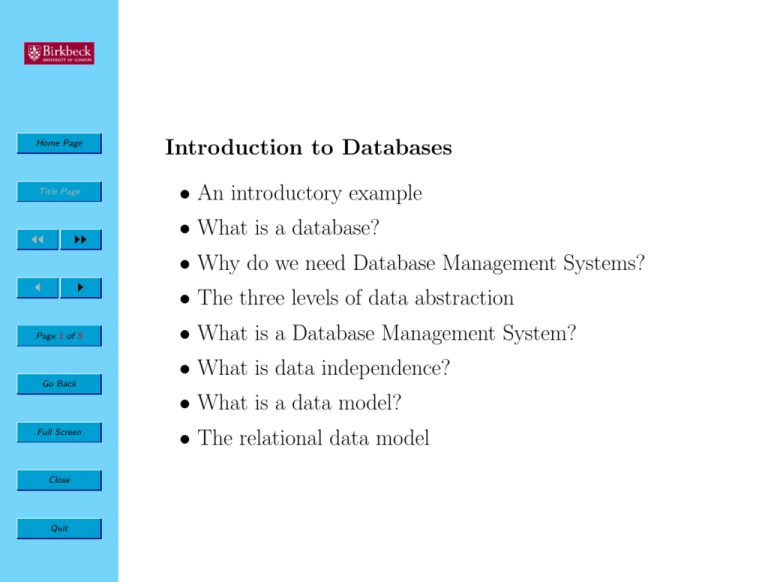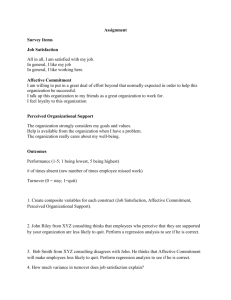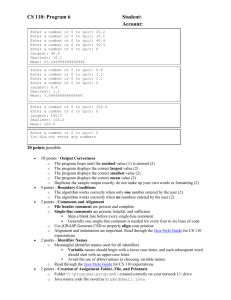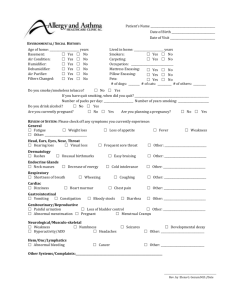Introduction - Department of Computer Science and Information
advertisement

Home Page Title Page JJ II Introduction to Databases • An introductory example • What is a database? • Why do we need Database Management Systems? J I Page 1 of 5 • The three levels of data abstraction • What is a Database Management System? • What is data independence? Go Back • What is a data model? Full Screen Close Quit • The relational data model Home Page Title Page JJ II J I Examples of Applications that use a Database • Banking • Booking a holiday • Shopping − Inventory control Page 2 of 5 Go Back Full Screen Close Quit • E-commerce − E.g. Online Book Stores • The Invisible Web Home Page Title Page JJ II J I Page 3 of 5 Go Back Full Screen Close Quit Initial Definition of a Database. A database is an organised collection of inter-connected data items. Initial Definition of a Database Management System (DBMS). A DBMS is a computer system which is responsible for efficient storage and retrieval of the data items in a database. Home Page Title Page JJ II J I An introductory Example The following concepts will be discussed, via a simple fragment of a library database: • tuples (rows), relations (tables) and relational databases (databases). • entity sets and entities (objects). Page 4 of 5 Go Back Full Screen Close Quit • attributes, attribute values and domains. • relation schema (header) and entity type (object type). • relational database schema (database headers). Home Page The Books Relation AUTHOR1 SHORT TITLE PUBLISHER Atzeni DB Theory Benjamin/Cummings Date Introduction to DBs Addison-Wesley Korth DB Concepts McGraw-Hill Mannila The Design of DBs Addison-Wesley Ullman Principles of DBs Computer Science Press YEAR 1993 1990 1991 1992 1988 Title Page JJ II J I Page 5 of 5 Go Back Full Screen Close Quit ISBN 0-8053-0249-2 0-201-52878-9 0-07-044754-3 0-201-56523-4 0-7167-8158-1 The Loans Relation LOCATION QUANTITY Science 1 Main 3 Main 1 Science 1 Main 2 LOAN 0 2 1 0 1 ISBN 0-8053-0249-2 0-201-52878-9 0-07-044754-3 0-201-56523-4 0-7167-8158-1 Home Page Title Page JJ II J I Page 6 of 5 Go Back Full Screen Close Quit What is a Database? Definition of a database. 1. A database is a collection of persistent data (or information). 2. A database models part of the real world, called the enterprise. 3. A database is, in general, a shared resource. Home Page Title Page JJ II J I Page 7 of 5 Go Back Full Screen Close Quit Why Do We Need DBMSs? Assume that a DBMS is a software (and hardware) package that handles all the interaction of an application with the database. 1. It saves programmer time and maintenance. 2. It provides data independence. 3. It provide provides programmers with various tools. Home Page Title Page JJ II J I Page 8 of 5 Go Back Full Screen Close Quit The Three Levels of Data Description This framework describes the interfaces and the information that should pass between them: 1. physical (or internal) - normally machine dependent. 2. conceptual (or logical) - based on a data model. 3. view (or external) - corresponds to application programs or user groups. View 1 schema Home Page View 2 schema f1 f2 Title Page Conceptual database schema JJ II J I g Page 9 of 5 Go Back Full Screen Close Quit Physical schema View n schema fn Home Page Title Page What is a Database Management System? A DBMS is a software (and hardware) package providing the following services: • A data definition language (DDL). • A data manipulation language (DML). JJ II J I • Efficiency in query response and storage space. • Maintenance of integrity and consistency. • Concurrency control and data sharing. Page 10 of 5 • Transaction management (commit and rollback). Go Back Full Screen • Recovery from failure. • Security. • Data administration facilities. Close • Adherence to standards (e.g. SQL). Quit Home Page Title Page JJ II J I What are the disadvantages of using a DBMS ? • Cost • Lock-in Page 11 of 5 Go Back Full Screen Close Quit • Complexity Home Page Title Page JJ II J I DBMS users • End users. • Application programmers. • Database administrator (DBA). Page 12 of 5 Go Back Full Screen Close Quit • Enterprise administrator - responsible for database design. • Application administrator - responsible for view design. Home Page Title Page JJ II J I Page 13 of 5 Go Back Full Screen Close Quit What is Data Independence? • physical data independence - the physical level may be changed without affecting the conceptual level. • growth independence - the independence of the view level from the addition of new attributes to relation schemas and new relation schemas to the database schema. ? Deletions of relations or columns from relations at the conceptual level disrupt views that reference those relations or columns. Home Page Title Page JJ II J I What is a Data Model? 1. Structural part. 2. Integrity part. Page 14 of 5 Go Back Full Screen Close Quit 3. Manipulative part - declarative or procedural. Home Page Title Page The Relational Data Model JJ II 1. Structural part - relations (tables). J I 2. Integrity part - keys (entity integrity) and foreign keys (referential integrity). Page 15 of 5 Go Back Full Screen Close Quit 3. Manipulative part - Structured Query Language (SQL) or the relational algebra. (E.g. select, project, join queries.) Home Page Title Page JJ II J I Page 16 of 5 Go Back Full Screen Close Quit Summary: • A database is a collection of persistent data that is shared and models an enterprise. • A DBMS is a computer system that provides the interface between database users and the database itself. • A DBMS has three levels of abstraction: physical, conceptual and view. • Data independence means that changing the schema at a lower level does not affect the higher level. • A data model has structural, integrity and manipulative parts.







